Aquila (genus)
| Aquila Temporal range: Middle Miocene to present | |
|---|---|
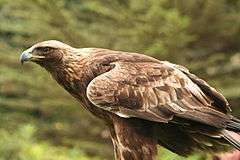 | |
| Aquila chrysaetos | |
| Scientific classification | |
| Kingdom: | Animalia |
| Phylum: | Chordata |
| Class: | Aves |
| Order: | Accipitriformes |
| Family: | Accipitridae |
| Subfamily: | Aquilinae |
| Genus: | Aquila Brisson, 1760 |
| Species | |
|
See text | |
| Synonyms | |
and see text | |
Aquila is the genus of true eagles. The genus name is Latin for "eagle", possibly derived from aquilus, "dark in colour".[1] It is often united with the buteos, sea eagles, and other more heavyset Accipitridae, but more recently they appear to be less distinct from the more slender accipitrine hawks than previously believed. Eagles are not a natural group, but denote essentially any bird of prey large enough to hunt sizeable (about 50 cm long or more overall) vertebrate prey.
Taxonomy and systematics
Aquila belongs to a close-knit group of "typical" eagles including genera Hieraaetus, Lophaetus, Ictinaetus, Clanga, and the extinct Harpagornis. This group occurs as a clade within the larger group of "booted" eagles (tribe Aquilini or subfamily Aquilinae).[2]
The plumage of the more basal members of the booted-eagle group, such as Spizaetus and Nisaetus, generally has barred underparts in adults, and is distinctly different in juveniles which have plain, pale underparts. In contrast, within the Aquila–Hieraaetus–Lophaetus clade, adults are generally dark, with juveniles more closely resembling the adults. Hieraaetus species have both dark and light (or "pied") morphs, with the latter having light, unbarred under-parts.[3]
Research in molecular genetics found Aquila and Hieraaetus to be polyphyletic. Between 2005 and 2014, the British Ornithologists' Union included both Bonelli's and the booted eagle in Aquila. Also, Clements' Checklist merged all Hieraetus species into Aquila from 2001 to 2009. The current approach is to keep Hieraaetus as a separate genus, with Bonelli's eagle and the African hawk-eagle moved into Aquila and Wahlberg's eagle moved into Hieraaetus.[4]
The spotted eagles (previously Aquila clanga, A. pomarina, A. (p.) hastata) are thought to be genetically closer to Ictinaetus and Lophoaetus than to other Aquila species, and may be placed into a separate genus, Clanga.[2]
Members of Aquila (excluding those moved to Clanga and Hieraaetus, but including A. fasciata/spilogaster) share two deletions in the (nuclear) LDH gene, as well as similarities in mitochondrial cyt-B gene sequence, though one of these deletions is reverted in A. chrysaetos.[3]
Species
| Image | Scientific name | Common Name | Distribution |
|---|---|---|---|
.jpg) | Aquila fasciata (formerly Hieraaetus fasciatus) | Bonelli's eagle | southern Europe, Africa both north and south of the Sahara Desert and across the Middle East and South Asia to Indonesia |
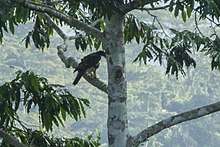 | Aquila africana (formerly Spizaetus africanus) | Cassin's hawk-eagle | West, central and marginally east Africa; from Sierra Leone east to western Uganda south through the Congo Basin to northern Angola |
.jpg) | Aquila spilogaster (previously a subspecies, H. f. spilogaster) | African hawk-eagle | tropical Sub-Saharan Africa |
 | Aquila chrysaetos | Golden eagle | Eurasia and North America |
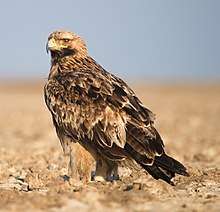 | Aquila heliaca | Eastern imperial eagle | northeastern Africa and southern and eastern Asia |
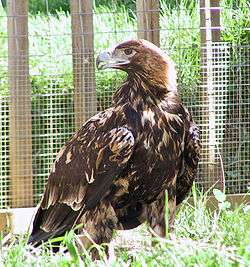 | Aquila adalberti | Spanish imperial eagle | central and south-west Spain and adjacent areas of Portugal, in the Iberian peninsula |
.jpg) | Aquila nipalensis | Steppe eagle | Romania east through the south Russian and Central Asian steppes to Mongolia |
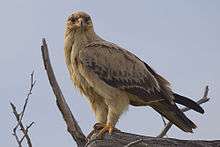 | Aquila rapax | Tawny eagle | Africa both north and south of the Sahara Desert and across tropical southwestern Asia to India. |
 | Aquila verreauxii | Verreaux's eagle | southern and eastern Africa (extending marginally into Chad), and very locally in West Africa, the Arabian Peninsula and the southern Middle East. |
| Aquila gurneyi | Gurney's eagle | Moluccas to Irian Jaya and most of New Guinea | |
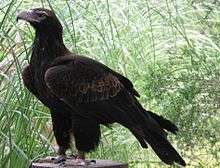 | Aquila audax | Wedge-tailed eagle | Australia, southern New Guinea, part of Papua New Guinea and Indonesia |
Former species
- Greater spotted eagle, Clanga clanga
- Lesser spotted eagle, C. pomarina
- Indian spotted eagle, C. hastata
- Wahlberg's eagle, Hieraaetus wahlbergii
Fossil record
Numerous fossil taxa of eagles have been described.[5][6] Many have been moved to other genera, but several appear to be correctly assigned to this genus:
- Aquila bullockensis (Middle Miocene)
- ?Aquila delphinensis (Middle/Late Miocene of Grive-Saint-Alban, France)
- ?Aquila pennatoides (Middle/Late Miocene of Grive-Saint-Alban, France)
- Aquila sp. (Late Miocene – Late Pliocene of S Europe)[6]
- Aquila sp. (Early Pliocene of Florida)
- Aquila bivia (Late Pliocene of S USA)
- Aquila kurochkini (Late Pliocene of Varshets, Bulgaria)[7]
- Aquila sp. (Middle Pleistocene of Castiglione, Corsica)[8]
- ?Aquila fossilis (Middle/Late Pleistocene of Monte Reale, Sardinia)
- ?Aquila sp. (Late Quaternary, Madagascar)[9]
Whether "Hieraaetus" edwardsi (Middle -? Late Miocene of SW Europe) belongs into Aquila or the hawk-eagles (if the latter are indeed distinct) is unclear. Its initial name, "Aquila" minuta Milne-Edwards, 1871, is preoccupied by a junior synonym of the booted eagle, A. minuta Brehm, 1831.
Not placed in Aquila anymore are:
- "Aquila" gervaisii – now in Palaeohierax
- "Aquila" borrasi, "A." sodalis – now in Buteogallus, B. borrasi was long placed in Titanohierax.
- "Aquila" pliogryps – now in Spizaetus
- "Aquila" corroyi, "A." depredator, "A." hypogaea, and "A." prisca – now in Aquilavus
- "Aquila" ferox, "A." lydekkeri – protostrigid owls, now in Minerva.
"Aquila" danana (Snake Creek Late Miocene/Early Pliocene of Loup Fork, USA), occasionally placed in Geranoaetus or Buteo, was a bird of prey of unclear relationships.
For paleosubspecies of living Aquila, see the species accounts.
References
| Wikimedia Commons has media related to Aquila. |
- ↑ Jobling, James A (2010). The Helm Dictionary of Scientific Bird Names. London: Christopher Helm. p. 52. ISBN 978-1-4081-2501-4.
- 1 2 Boyd, John Accipitriformes", Taxonomy in Flux Checklist.
- 1 2 Helbig, A.J.; Kocum, A.; Seibold, I. & Braun, M.J. "A multi-gene phylogeny of aquiline eagles (Aves: Accipitriformes) reveals extensive paraphyly at the genus level" (PDF). Science Direct, Journal of Molecular Phylogenetics and Evolution. Retrieved 2013-04-01.
- ↑ See article Hieraaetus for details.
- ↑ Brodkorb, Pierce (1964). "Catalogue of Fossil Birds: Part 2 (Anseriformes through Galliformes)". Bulletin of the Florida State Museum. 8 (3): 195–335.
- 1 2 Mlíkovský, Jirí (2002): Cenozoic Birds of the World, Part 1: Europe. Ninox Press, Prague, p. 194.
- ↑ Boev, Z., 2013. Aquila kurochkini sp. n., a New Late Pliocene Eagle (Aves, Accipitriformes) from Varshets (NW Bulgaria). - Paleontological Journal, 2013, Vol. 47, No. 11, pp. 1344–1354. Pleiades Publishing, Ltd., 2013.
- ↑ Salotti, Michelle; Bellot-Gourlet, Ludovic; Courtois, Jean-Yves; Dubois, Jean-Noël; Louchart, Antoine; Mourer-Chauviré, Cécile; Oberlin, Christine; Pereira, Elisabeth; Poupeau, Gérard; Tramoni, Pascal (2000). "La fin du Pléistocène supérieur et le début de l'Holocène en Corse: apports paléontologique et archéologique du site de Castiglione (Oletta, Haute-Corse)" [The end of the Late Pleistocene and the Early Holocene in Corsica: New paleontological and archaeological data from Castiglione deposit (Oletta, Haute-Corse)]. Quaternaire (English abstract) (in French). 11 (3): 219–230. doi:10.3406/quate.2000.1671.
- ↑ Madagascar and other Islands. Human Settlers Invade Paradise. Endangered Species Handbook. Retrieved on 2013-04-17.